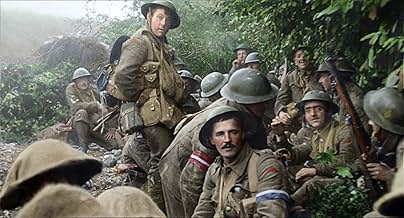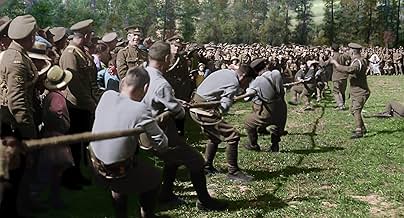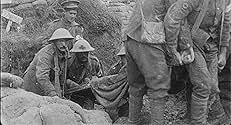CALIFICACIÓN DE IMDb
8.2/10
40 k
TU CALIFICACIÓN
Un documental sobre la Primera Guerra Mundial, con metraje inédito, para conmemorar el centenario de la guerra.Un documental sobre la Primera Guerra Mundial, con metraje inédito, para conmemorar el centenario de la guerra.Un documental sobre la Primera Guerra Mundial, con metraje inédito, para conmemorar el centenario de la guerra.
- Nominada a1 premio BAFTA
- 6 premios ganados y 14 nominaciones en total
Thomas Adlam
- Self - Bedfordshire Regiment
- (voz)
- (as Capt Thomas Adlam VC)
William Argent
- Self - Royal Naval Air Service
- (voz)
- (as LM William Argent)
John Ashby
- Self - The Duke of Cambridge's Own (Middlesex Regiment)
- (voz)
- (as Cpl John Ashby)
Attwood
- Self - British Army
- (voz)
- (as Cpl Attwood)
Walter Aust
- Self - East Yorkshire Regiment
- (voz)
- (as Pte Walter Aust)
Donald Bain
- Self - Seaforth Highlanders
- (voz)
- (as Pte Donald Bain)
Thomas Baker
- Self - Chatham Battalion, Royal Naval Division
- (voz)
- (as Pte Thomas Baker)
George Banton
- Self - 50th Division Headquarters
- (voz)
- (as Sig George Banton)
Walter Becklake
- Self - Northhampyonshire Yeomanry
- (voz)
- (as L Cpl Walter Becklake MM)
Arthur Beeton
- Self - Royal Navy Air Service
- (voz)
- (as POM Arthur Beeton)
Robert Bell
- Self - British Army
- (voz)
- (as Mr Robert Bell)
William Benham
- Self - Hawke Battalion, Royal Navy Division
- (voz)
- (as Sub Lt William Benham)
Joseph Biglin
- Self - Durham Light Infantry
- (voz)
- (as Pte Joseph Biglin)
Edwin Bigwood
- Self - Worcestershire Regiment
- (voz)
- (as Pte Edwin Bigwood)
Horace Birks
- Self - Tanks Corps
- (voz)
- (as Capt Horace Birks)
Edmund Blunden
- Self - Royal Sussex Regiment
- (voz)
- (as Lt Edmund Blunden MC)
Clarence Bourne
- Self - Army Service Corps
- (voz)
- (as S Sgt Clarence Bourne)
Allan Bray
- Self - The Duke of Edinburgh's ((Whiltshire Regiment))
- (voz)
- (as L Cpl Allan Bray)
Opiniones destacadas
I needed some time for this to sink in before commenting on it. This was equal parts funny, exciting, moving, harrowing, horrifying, upsetting.
Firstly, it's not a glossy documentary. There are some harrowing scenes in this that will, and should, upset you.
The first 25 minutes are of original black and white, speeded up footage with the original voices of troops telling their story over the top of it.
Then something amazing happens. The screen widens, the footage smoothes out, the colours shines through and in an instant your and seeing everything in so much more detail.
That said this was the first time I've seen footage from The Great War that didn't feel disconnected. It feels real. Seeing the colour on their cheeks and eyes, the dirt, the mud, the blood brings the old footage to life. Occasionally the colourisation takes on a slightly animated feel but never enough to draw you out of the engrossing scenes laid out before you.
Then the frame rate adjustment is amazing. Having computers generate the missing frames to adjust the variable 15-18fps to the regular 24fps is a visual butter knife that smoothes out the jerky footage.
Having the soldiers talk sounds like a mistake but it's done in such a subtle and sensitive way it never feels false. They've been lip synced perfectly and apparently even with the right accent for the infantry units depicted.
This was powerful viewing. Computers and technology being used for something so important, to allow 100+ year old footage to look so modern and yet not feel sanitised is amazing.
This should become compulsory viewing for every one, all schools too.
With footage thats this accessible there's no reason history should be forgotten.
Firstly, it's not a glossy documentary. There are some harrowing scenes in this that will, and should, upset you.
The first 25 minutes are of original black and white, speeded up footage with the original voices of troops telling their story over the top of it.
Then something amazing happens. The screen widens, the footage smoothes out, the colours shines through and in an instant your and seeing everything in so much more detail.
That said this was the first time I've seen footage from The Great War that didn't feel disconnected. It feels real. Seeing the colour on their cheeks and eyes, the dirt, the mud, the blood brings the old footage to life. Occasionally the colourisation takes on a slightly animated feel but never enough to draw you out of the engrossing scenes laid out before you.
Then the frame rate adjustment is amazing. Having computers generate the missing frames to adjust the variable 15-18fps to the regular 24fps is a visual butter knife that smoothes out the jerky footage.
Having the soldiers talk sounds like a mistake but it's done in such a subtle and sensitive way it never feels false. They've been lip synced perfectly and apparently even with the right accent for the infantry units depicted.
This was powerful viewing. Computers and technology being used for something so important, to allow 100+ year old footage to look so modern and yet not feel sanitised is amazing.
This should become compulsory viewing for every one, all schools too.
With footage thats this accessible there's no reason history should be forgotten.
A century later, Peter Jackson produced an informative and fascinating documentary about the First World War, seen by the English, in the trenches of the Bay of Somme, with dusted and colored archive images.
Almost everyone expected a brief and victorious war, which, as it was said at the time, would be "over at Christmas". The continuation was very different and became a trench war. Hygiene was deplorable until it became laughable but the atmosphere within the troops was fraternal despite the constantly oppressive atmosphere.
And we also learn that the English infantrymen regularly had a mission to capture a Fritz. Knowing that from a military strategy point of view, this is a complete nonsense, a war prisoner being systematically an useless and cumbersome dead weight, it is perhaps a pity that this documentary does not give to the audience an explicit explanation. And the only rational explanation is probably this one: to force the English infantrymen to attack the Germans, the prisoner of war being the proof of the effectiveness of their attack ...
Almost everyone expected a brief and victorious war, which, as it was said at the time, would be "over at Christmas". The continuation was very different and became a trench war. Hygiene was deplorable until it became laughable but the atmosphere within the troops was fraternal despite the constantly oppressive atmosphere.
And we also learn that the English infantrymen regularly had a mission to capture a Fritz. Knowing that from a military strategy point of view, this is a complete nonsense, a war prisoner being systematically an useless and cumbersome dead weight, it is perhaps a pity that this documentary does not give to the audience an explicit explanation. And the only rational explanation is probably this one: to force the English infantrymen to attack the Germans, the prisoner of war being the proof of the effectiveness of their attack ...
100 years on from the Great War we cannot pretend to know what life was like serving in the trenches. This incredible film brings us as close to experiencing it as we are ever going to get.
It is harrowing, it is poignant, it is funny. Above all else this film is heartbreaking. No punch is pulled, no attempt is made to hide the brutality of war or the hardship of the common soldier.
Quite simply this amazing documentary should be made compulsory viewing in all schools and for every soapbox, warmongering politician that would send our youth into hell.
It is harrowing, it is poignant, it is funny. Above all else this film is heartbreaking. No punch is pulled, no attempt is made to hide the brutality of war or the hardship of the common soldier.
Quite simply this amazing documentary should be made compulsory viewing in all schools and for every soapbox, warmongering politician that would send our youth into hell.
As this historically important anniversary draws to a close, I just want to say that my viewing of this film was that of utter amazement. As a photo colouriser/restorer, I was absolutely astonished at the work PJ's team put into this. The transition from the original film material, then to the stabilised and corrected FPS and then the full colour and sound was one of the most spectacular things I have ever seen on the screen. The colour is natural and really helps emphasise the grittiness of war and brings out hidden details that may have been missed in the B&W source. Usually I prefer film not to be tampered with, but as Jackson says, this is how the men saw it - in living colour. The addition of the voiceovers from the surviving soldiers themselves is a great choice and doesn't distract and flows along nicely with the visuals. Throughout I expressed various emotions of sadness and shock, but surprisingly a few laughs, particularly one shot showing a soldier banging a tune on another soldiers helmet as they march.
I do wish I had seen this on the big screen and I imagine what I have said is enhanced 100x more with that type of viewing. A fitting tribute to the men that did and didn't come home and I hope it is recognised and picks up many awards.
10mattwidd
I was lucky enough to bag a ticket to the one off showing of Peter Jackson's They Shall Not Grow Old, having watched a lot of World War One documentaries and made countless visits to historic sites across France and Belgium I was keen to see what was being marketed as a 'new' perspective on The Great War, it did not disappoint.
Jackson chose to create a narrow focus narrative for this 1 hour 30 minute documentary to allow the viewer to delve into the fine details often missed in more sweeping documentaries trying to cover all aspects and areas of the conflict. Jackson chose to look closely at the lives and experiences of British native frontline troops in Belgium. The documentary follows a linear timeline beginning with the breakout of war and the initial volunteering of thousands of young men excited and ready for an adventure for King and Country and ends with the great sense of loss and uncertainty of the future the troops had by the end of the war.
The entire documentary is narrated by records of surviving troops recorded in the 60s and 70s, this was an intentional move by Jackson that definitely adds to the ability for the viewer to connect and relate to the survivors.
I especially found the stories and anecdotes about the goings on behind the lines during down time and R&R for the troops captivating as it is often over looked in other documentaries solely concentrating on the combat and horrors of war.
The pain staking effort and lengths Jackson and his team went to to restore this footage not only with colour but with frame rate, sharpness and especially sound is breath taking. Taking the time to have professional lip readers painstakingly review all the footage so allow us to then know and hear what was being said truly brought the footage to life.
My only issue with the film, something that is made note of by Jackson is of course because of the time in history and available cameras there is no actual combat footage available so you do spend a large amount of time just watching still hand drawn cartoons of the battles from the time, something that cannot be avoided but does detract from the immersion the rest of the film creates.
I highly recommend this film to everyone, it is important we see the true perspective of what our ancestors went through and never forget these brave men and women.
¿Sabías que…?
- TriviaMuch of the footage had never been seen, having sat in the vaults of London's Imperial War Museum for many years.
- ErroresSeveral shots of tanks appear in the film, both Mark V (Mark Five) and Mark V* (Mark Five Star). They have been colourised green. In reality, tanks of these types were painted "a neutral brown colour". See the article by the British Tank Museum which states that. "Surrendering to the inevitable, towards the end of 1916 it was ordered that the tanks should be painted in a 'neutral brown colour' all over." These tanks entered service in 1918, and were factory-painted brown.
- Citas
Soldier: [waving at camera] Hi, mum.
- Créditos curiosos"Filmed on location on the Western Front, 1914 to 1918"
- ConexionesFeatured in Front Row: Episode #3.3 (2018)
Selecciones populares
Inicia sesión para calificar y agrega a la lista de videos para obtener recomendaciones personalizadas
- How long is They Shall Not Grow Old?Con tecnología de Alexa
Detalles
- Fecha de lanzamiento
- Países de origen
- Sitios oficiales
- Idioma
- También se conoce como
- They Shall Not Grow Old
- Locaciones de filmación
- Productoras
- Ver más créditos de la compañía en IMDbPro
Taquilla
- Total en EE. UU. y Canadá
- USD 17,956,913
- Total a nivel mundial
- USD 21,656,913
- Tiempo de ejecución
- 1h 39min(99 min)
- Color
- Mezcla de sonido
- Relación de aspecto
- 1.33 : 1(original footage)
- 1.85 : 1
Contribuir a esta página
Sugiere una edición o agrega el contenido que falta



















